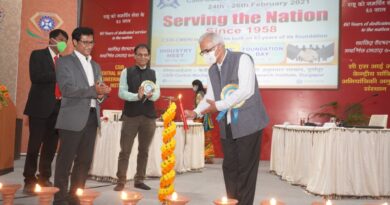SOLAR pump program needs relook because of large–scale land degradation, groundwater exploitation & farmers ‘distress: CSE
Central government’s KUSUM scheme aims to install large number of solar pumps might result in over-exploitation of groundwater in water-scarce regions. Solar pumps are unable to provide adequate irrigation due to depleting groundwater, says The Delhi based Centre for Science & Environment abbreviated as CSE.Existing solar pump schemes do not benefit small farmers. Income benefits of KUSUM’s proposed “solar plants on farm land” scheme will go to wealthy farmers.KUSUM may not help reduce Discoms’ subsidy burden since installation of pumps is not mandatorily tied to decrease in subsidised agricultural power supply, CSE says in its report made public Maharashtra’s Aurangabad on August 9. Central and state governments are promoting solar power to meet India’s irrigation requirements. The recently approved KUSUM scheme alone targets to install 17.5 lakh off-grid and 10 lakh on-grid solar pumps and 10 GW of solar power plants capacity in rural areas by 2022. The objective is to meet multiple ambitious goals – provide access to assured irrigation, increase farmer income through sale of surplus power, reduce electricity subsidy burden (~Rs 50,000 crores) and expand the distributed renewable energy capacity. But will the multitude of objectives be met? Unlikely, asserts Centre for Science and Environment (CSE) in its latest report titled Silver Bullet: Are Solar pumps a panacea for irrigation, farmer distress and discom losses? The report is supported by CSE’s surveys of farmers in three districts in Maharashtra, Uttar Pradesh and Andhra Pradesh.In some areas, solar pumps can help meet irrigation requirement, however, CSE’s survey of farmers in Pilibhit, Uttar Pradesh pointed to overexploitation of water and misuse of pump due to poor policy design and implementation. “Clean energy does not always mean green solution. We have enough evidence from states like Punjab, Haryana and Tamil Nadu about the impact of highly subsidized electricity on groundwater withdrawal. Large-scale solar pump deployment without a comprehensive plan to monitor and control water usage would be equally disastrous,” said Chandra Bhushan, deputy director general, CSE, at a public meeting organised in Aurangabad, Maharashtra to share the report. Speaking at the meeting, H M Desarda, former member of Maharashtra’s State Planning Board agreed: “Increased dependence on groundwater for irrigation has resulted in improving agricultural yields, but it has also led to depletion of groundwater resources at an alarming rate.”Off-grid pumps – the focus of various schemes – pose the most serious risk of over-extraction of groundwater given power generated by them can’t be injected into the grid. They are also uneconomical since they are underused — survey of farmers in Buldhana, Maharashtra, showed utilization of pumps was as low as 33 per cent.The two new models suggested in the KUSUM scheme — solarisation of agricultural feeders and on-grid solar pumps — are economically superior to off-grid pumps since excess electricity can be injected into the grid. However, none of the alternatives have specific measures or mandates to limit water use. The solar pump schemes have so far mostly failed to benefit their intended target group – small farmers. CSE found that in Pilibhit most of the subsidised solar pumps had been installed by large farmers. The KUSUM scheme proposes installing solar plants on farm land. This option will require large investment or the ability to lease land for 25 years, which will likely exclude small farmers.“Although KUSUM aims to reduce subsidy burden of state Discoms, it does not have any clear goals or provisions to ensure subsidy reduction. The subsidised solar pumps are being installed without accompanying cuts in agricultural supply or a reduction in subsidy. The result may, therefore, be an increase in total subsidy burden on states,” said Mandvi Singh, programme manager, renewable energy, CSE.
“The wide range of goals being pursued by KUSUM needs a comprehensive approach including reforms in agricultural support price, rationalisation of power tariff, direct benefit transfer and water-efficient irrigation. But, first, it needs to get the basics right – promote an appropriate solar pump model based on local groundwater scenario, ensure groundwater is not over-exploited, focus on small farmers, and reduce subsidised power supply,” says Priyavrat Bhati, advisor-energy, CSE. Key recommendations of the CSE report: Solar pump schemes should accompany explicit and strict measures of monitoring and control to manage groundwater extraction. Funds for solar pump schemes should be extended only to states willing to take such measures.Solarization of feeders may be the most economical solution, but needs to be accompanied by gradual increase in agricultural tariffs and limits on hours of power supply.On-grid pumps are an alternative for water-scarce regions with high farmer distress, but adequate FiTs and one-way power flow (as opposed to net meter) is necessary to limit water withdrawal.Off-grid pumps should be considered only in exceptional cases, for unelectrified regions with relatively high water-table, and utilization should be increased through a mini-grid model in which excess electricity can be used in households or for other economic uses. Clear targets must be set to provide solar pumps to small and marginal farmers. Providing access to financing is a crucial support needed by this segment.Efficient discom operations should be ensured by regulatory mandates for regular reporting on installations, operations, evacuation, billing and payment to farmers.
“The solar pump programme certainly needs a relook considering the large–scale land degradation, groundwater exploitation and farmers distress in the country. It is very much possible to increase renewable energy, reduce groundwater exploitation and help small and marginal farmers. But for this, KUSUM scheme has be viewed as a water and agriculture scheme and not merely as a renewable energy scheme,” said Chandra Bhushan.




